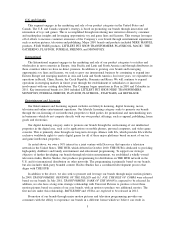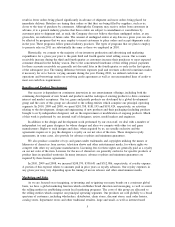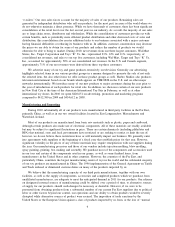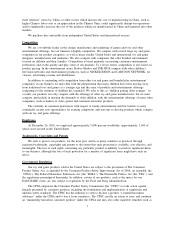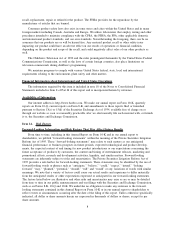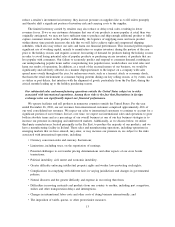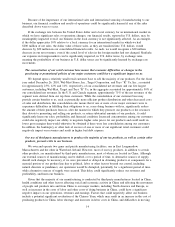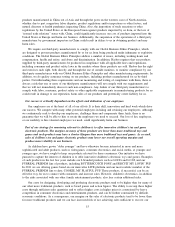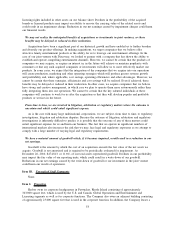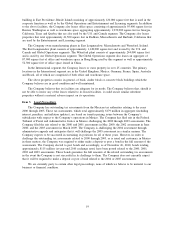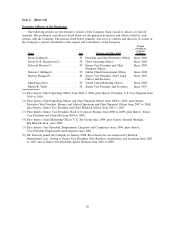Hasbro 2010 Annual Report Download - page 22
Download and view the complete annual report
Please find page 22 of the 2010 Hasbro annual report below. You can navigate through the pages in the report by either clicking on the pages listed below, or by using the keyword search tool below to find specific information within the annual report.outside of our control could further delay our products or increase the cost we pay to produce such products.
For example, work stoppages, slowdowns or strikes, an outbreak of a severe public health pandemic, or the
occurrence or threat of wars or other conflicts, all could impact our ability to manufacture or deliver product.
Any of these factors could result in product delays, increased costs and/or lost sales for our products.
We may not realize the full benefit of our licenses if the licensed material has less market appeal than
expected or if revenue from the licensed products is not sufficient to earn out the minimum guaranteed
royalties.
In addition to designing and developing products based on our own brands, we seek to fulfill consumer
preferences and interests by producing products based on popular entertainment properties developed by other
parties and licensed to us. The success of entertainment properties for which we have a license, such as
MARVEL or STAR WARS related products, can significantly affect our revenues and profitability. If we
produce a line of products based on a movie or television series, the success of the movie or series has a
critical impact on the level of consumer interest in the associated products we are offering. In addition,
competition in our industry for access to entertainment properties can lessen our ability to secure, maintain,
and renew popular licenses to entertainment products on beneficial terms, if at all, and to attract and retain the
talented employees necessary to design, develop and market successful products based on these properties.
The loss of rights granted pursuant to any of our licensing agreements could harm our business and
competitive position.
The license agreements we enter to obtain these rights usually require us to pay minimum royalty
guarantees that may be substantial, and in some cases may be greater than what we are ultimately able to
recoup from actual sales, which could result in write-offs of significant amounts which in turn would harm our
results of operations. At December 26, 2010, we had $112,922 of prepaid royalties, $17,922 of which are
included in prepaid expenses and other current assets and $95,000 of which are included in other assets. Under
the terms of existing contracts as of December 26, 2010, we may be required to pay future minimum
guaranteed royalties and other licensing fees totaling approximately $287,000. Acquiring or renewing licenses
may require the payment of minimum guaranteed royalties that we consider to be too high to be profitable,
which may result in losing licenses we currently hold when they become available for renewal, or missing
business opportunities for new licenses. Additionally, as a licensee of entertainment based properties we have
no guaranty that a particular property or brand will translate into successful toy or game products.
We anticipate that the shorter theatrical duration for movie releases may make it increasingly difficult for
us to profitably sell licensed products based on entertainment properties and may lead our customers to reduce
their demand for these products in order to minimize their inventory risk. Furthermore, there can be no
assurance that a successful brand will continue to be successful or maintain a high level of sales in the future,
as new entertainment properties and competitive products are continually being introduced to the market. In
the event that we are not able to acquire or maintain successful entertainment licenses on advantageous terms,
our revenues and profits may be harmed.
Our business is seasonal and therefore our annual operating results will depend, in large part, on our
sales during the relatively brief holiday shopping season. This seasonality is exacerbated by retailers’
quick response inventory management techniques.
Sales of our family entertainment products at retail are extremely seasonal, with a majority of retail sales
occurring during the period from September through December in anticipation of the holiday season, including
Christmas. This seasonality has increased over time, as retailers become more efficient in their control of
inventory levels through quick response inventory management techniques. Customers are timing their orders
so that they are being filled by suppliers, such as us, closer to the time of purchase by consumers. For toys,
games and other family entertainment products which we produce, a majority of retail sales for the entire year
generally occur in the fourth quarter, close to the holiday season. As a consequence, the majority of our sales
to our customers occur in the period from September through December, as our customers do not want to
maintain large on-hand inventories throughout the year ahead of consumer demand. While these techniques
12



